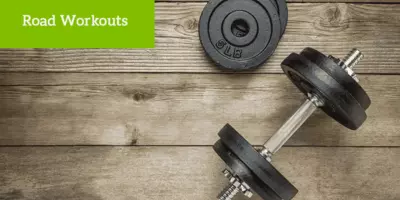Sep 25, 2015 ● Miranda Pennington
Road Workouts for Truck Drivers: Part 2
If you missed our last post, be sure you go back for Part 1 of Road Workouts-- it covered some preparation steps you shouldn't skip before launching into a new regimen. This post will focus more on specific exercises and muscle groups as suggested by the folks at Roadmaster.com. This list of exercises should provide you with about two weeks worth of regular workouts--if you move from one exercise to another quickly, you can also score some cardio benefits!
Shoulders
For many of these exercises, you'll need only very light (if any) weights--shoulders are delicate, so go easy until you know you won't be in danger of tearing or too sore the next day.- Swimmers: Laying on your stomach, lift your arms out to the side a few inches and move them forward in unison as though swimming. Optional extension: Make small circles and slide your shoulder blades down your back.
- Lateral Extensions: While sitting upright or standing, bend your elbows so your hands point forward and your elbows are tucked in at your waist. Raise your elbows until they're almost even with your shoulders, then back down--almost like you're imitating a chicken. Use moderate weights if you'd like.
- Delt Extensions: (Front) With your arms held straight at your sides, thumbs facing forward, raise your hands straight out in front and back down. (Rear) Reach back and out while raising your arms behind you in the same motion. This exercise may benefit from appropriate use of weights--just make sure you're not locking your knees.
- Shrugs: Easy to do even while stopped in traffic, "shrug" with exaggerated motions. Raise your shoulders all the way to your ears and drop them back down, seeing how far you can slide your shoulder blades down your spine. Holding tension in the shoulders is very common, and shrugging and releasing can help you realize when you're unconsciously clenching, which can contribute to upper and lower back pain, and even headaches.
Arms
One temptation to avoid with arm exercises is using your torso to gain momentum or rock towards the weight being lifted. Instead, remain still and focus on the specific muscles you're trying to flex.- Bicep curls: Just like it sounds.
- Overhead Tricep Extensions: Stretching up and over your head to either side--if you practice this stretch against a resistant surface it can be a great side and back stretch too.
- Dips: Supporting your weight on your arms, raise and lower your body from a variety of angles.
- Forearm Curls: Same as with your bicep, just emphasizing the wrists.
- Grips: Think of it as arm wrestling prep--and don't burn out your joints so it's too hard to steer.
Chest
Form is especially crucial with chest work because it can lead to working arms or shoulders instead--when attempting any kind of push-up, make sure to also flex your core so you don't strain your back muscles.- Push-ups: Make this classic more challenging by moving your hands closer together (even attempt a diamond formation!) or further apart. Try having toes or knees on the floor, or clapping between each push.
- Incline push-ups: Place your hands on a surface that's higher than your feet, so even on the "down" of the pushup, your upper body is at an upward angle from the ground.
- Decline push-ups: The opposite of the last version--put your feet up higher than your head and hands. Stand up gradually after this one so the blood doesn't drain out of your head all at once and leave you dizzy.
- Uneven Pushups: Put one hand on a raised surface or platform and the other on the ground--make sure you even back out by swapping sides halfway through.
Back
- Superman: Similar to the swimmer, while laying on your stomach reach forward and up, and back and up, so your limbs are off the ground while flexing your torso. Extend past the ends of your fingertips and toes, and straighten your neck by looking at the ground and reaching through the top of your head.
- Pull-Ups: Full disclosure I have never done a pull up in my life or a flex-and-hang for longer than a few seconds, but I do know they make portable bars you can install and easily take down, if you're into that sort of thing.
Abs
If you have a chance to take a pilates class (great for men especially, since they often don't get the same kind of training that isolates abdominal muscles), focus especially on how to contract your core. Essentially you want to keep your lower back on the floor and contract your abs in order to "sit up" with your ribcage and upper torso.- Sit-ups/Crunches: Practice holding your hands behind your head or straight up in the air (try holding a ball or other small weight), bringing your elbow to your opposite knee for an oblique crunch, or pulling your legs up to a 90 degree angle while you crunch toward your knees.
- Planks: With your hands planted on the ground or bracing on your elbows, planks are great for stretching after crunches--check out some beginners yoga online or in a studio near you for how to embellish with twists or stretch into upward-facing dog to counter all the crunching.
- Holds/Flexes: This one is great because you can do it sitting down, while driving or while standing around. Keep your abs flexed while you inhale, or make a game out of it while you're behind the wheel.
Legs
Build on the legwork that occurs during your cardio exercise with these additional stretches- Wall-sits: With your back against a stable surface, slide down until your knees are over your toes (don't let them go past!). See how long you can hold it, or for a more intense stretch, step away from the wall and bring your arms over your head.
- Lunges: Hands on hips, step forward and bend one knee to get both a leg and a groin stretch. Don't forget to pay attention to the back leg--come onto your back toes and straighten that leg too.
- Calf raises: This is a great quick rest-stop stretch--find a curb and step on to it, then move your heels back gradually until they touch the ground. Lean forward into the stretch.
- Step-ups: Use the step of your truck or that same study curb--raise your knees higher for an extra boost, and match it by moving your arms together in a large circle beginning to the right, raising over your head and coming down on the left, then reversing. Alternate which foot you start with for each repetition.
- Squats: Make sure your knee doesn't bend in front of your toes--if it does, you're going too far down and can start damaging your knee cartilage.


